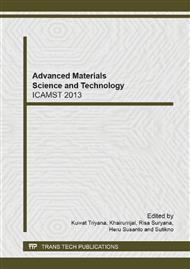[1]
R.J. Brook, Superhard ceramics, Nature 400 (1999) 312–315.
Google Scholar
[2]
A. Maitre, A. Vande Put, J.P. Laval, S. Valette, G. Trolliard, Role of boron on the spark plasma sintering of an α-SiC powder, J. Eur. Ceram. Soc. 28 (2008) 1881–1890.
DOI: 10.1016/j.jeurceramsoc.2008.01.002
Google Scholar
[3]
Z. Shen, M. Johnsson, Z. Zhao, M. Nygren, Spark plasma sintering of alumina, J. Am. Ceram. Soc. 85 (2002) 1921–(1927).
DOI: 10.1111/j.1151-2916.2002.tb00381.x
Google Scholar
[4]
H. Park, H. -E. Kim, K. Niihara, Microstructural evolution and mechanical properties of Si3N4 with Yb2O3 as a sintering additive, J. Am. Ceram. Soc. 80, 3(1997) 750–756.
DOI: 10.1002/chin.199725011
Google Scholar
[5]
Y. -W. Kim, M. Mitomo, H. Emoto, Effect of initial α-phase content on microstructure and mechanical properties of sintered silicon carbide, J. Am. Ceram. Soc. 81 (1998) 3136–3140.
DOI: 10.1111/j.1151-2916.1998.tb02748.x
Google Scholar
[6]
S. Dutta, B. Buzek, Microstructure, strength, and oxidation of a 10wt% Zyttrite-Si3N4 ceramic, J. Am. Ceram. Soc. 67 (1984) 89–92.
DOI: 10.1111/j.1151-2916.1984.tb09621.x
Google Scholar
[7]
B.T. Lee, K. Hiraga, D. Shindo, Microstructure of pressure-less-sintered Al2O3-24 vol% ZrO2 composite studied by high-resolution electron microscopy, J. Mater. Sci. 29 (1994) 959–964.
DOI: 10.1007/bf00351417
Google Scholar
[8]
K. Terao, Y. Miyamoto, M. Koizumi, Characteristics of ZrO2-dispersed Si3N4 without additives fabricated by hot isostatic pressing, J. Am. Ceram. Soc. 71 (1988) C-167–C-169.
DOI: 10.1111/j.1151-2916.1988.tb05044.x
Google Scholar
[9]
L. Anggraini, R. Yamamoto, H. Fujiwara, K. Ameyama, Effect of mechanical milling and sintering parameters on the mechanical properties of SiC-ZrO2 composite with a network microstructure, J. Ceram. Sci. Tech. 2, 3(2011) 139–146.
Google Scholar
[10]
G.R. Anstis, P. Chantikul, B.R. Lawn, D.B. Marshall, A critical evaluation of indentation techniques for measuring fracture toughness: I, Direct crack measurements, J. Am. Ceram. Soc. 64 (1981) 533–538.
DOI: 10.1111/j.1151-2916.1981.tb10320.x
Google Scholar
[11]
M. Tokita, N. Tamari, T. Takeuchi, Y. Makino, Consolidation behavior and mechanical properties of SiC with Al2O3 and Yb2O3 consolidated by SPS, J. Jpn. Soc. Powder Powder Metall. 56 (2009) 788–195.
DOI: 10.2497/jjspm.56.788
Google Scholar
[12]
H. Cheloui, Z. Zhang, X. Shen, F. Wang, S. Lee, Microstructure and mechanical properties of TiB-TiB2 fabricated by spark plasma sintering, Mater. Sci. Eng. A. 528 (2011) 3849–3853.
DOI: 10.1016/j.msea.2011.01.096
Google Scholar


